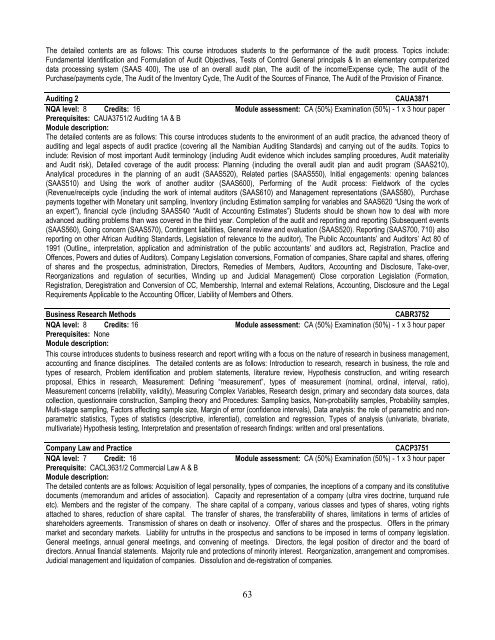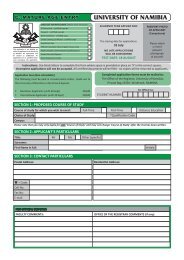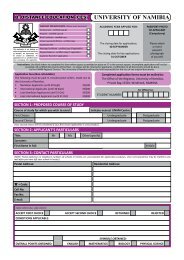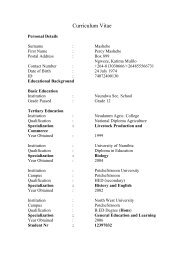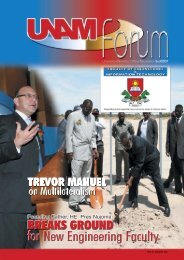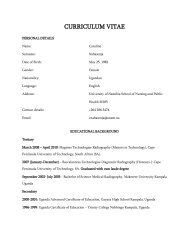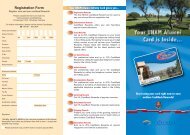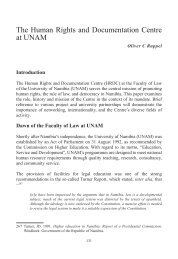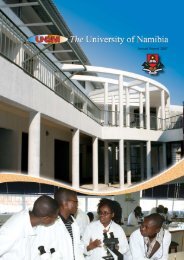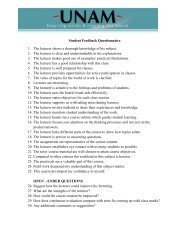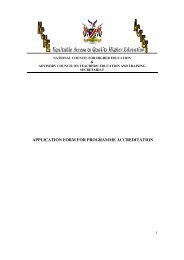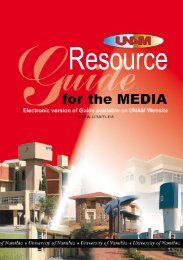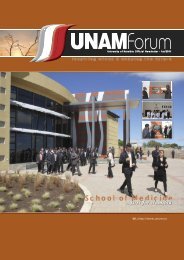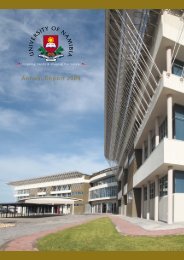UNIVERSITY OF NAMIBIA CENTRE FOR EXTERNAL STUDIES ...
UNIVERSITY OF NAMIBIA CENTRE FOR EXTERNAL STUDIES ...
UNIVERSITY OF NAMIBIA CENTRE FOR EXTERNAL STUDIES ...
You also want an ePaper? Increase the reach of your titles
YUMPU automatically turns print PDFs into web optimized ePapers that Google loves.
The detailed contents are as follows: This course introduces students to the performance of the audit process. Topics include:Fundamental Identification and Formulation of Audit Objectives, Tests of Control General principals & In an elementary computerizeddata processing system (SAAS 400), The use of an overall audit plan, The audit of the income/Expense cycle, The audit of thePurchase/payments cycle, The Audit of the Inventory Cycle, The Audit of the Sources of Finance, The Audit of the Provision of Finance.Auditing 2CAUA3871NQA level: 8 Credits: 16 Module assessment: CA (50%) Examination (50%) - 1 x 3 hour paperPrerequisites: CAUA3751/2 Auditing 1A & BModule description:The detailed contents are as follows: This course introduces students to the environment of an audit practice, the advanced theory ofauditing and legal aspects of audit practice (covering all the Namibian Auditing Standards) and carrying out of the audits. Topics toinclude: Revision of most important Audit terminology (including Audit evidence which includes sampling procedures, Audit materialityand Audit risk), Detailed coverage of the audit process: Planning (including the overall audit plan and audit program (SAAS210),Analytical procedures in the planning of an audit (SAAS520), Related parties (SAAS550), Initial engagements: opening balances(SAAS510) and Using the work of another auditor (SAAS600), Performing of the Audit process: Fieldwork of the cycles(Revenue/receipts cycle (including the work of internal auditors (SAAS610) and Management representations (SAAS580), Purchasepayments together with Monetary unit sampling, Inventory (including Estimation sampling for variables and SAAS620 “Using the work ofan expert”), financial cycle (including SAAS540 “Audit of Accounting Estimates”) Students should be shown how to deal with moreadvanced auditing problems than was covered in the third year. Completion of the audit and reporting and reporting (Subsequent events(SAAS560), Going concern (SAAS570), Contingent liabilities, General review and evaluation (SAAS520). Reporting (SAAS700, 710) alsoreporting on other African Auditing Standards, Legislation of relevance to the auditor), The Public Accountants’ and Auditors’ Act 80 of1991 (Outline,, interpretation, application and administration of the public accountants’ and auditors act, Registration, Practice andOffences, Powers and duties of Auditors). Company Legislation conversions, Formation of companies, Share capital and shares, offeringof shares and the prospectus, administration, Directors, Remedies of Members, Auditors, Accounting and Disclosure, Take-over,Reorganizations and regulation of securities, Winding up and Judicial Management) Close corporation Legislation (Formation,Registration, Deregistration and Conversion of CC, Membership, Internal and external Relations, Accounting, Disclosure and the LegalRequirements Applicable to the Accounting Officer, Liability of Members and Others.Business Research MethodsCABR3752NQA level: 8 Credits: 16 Module assessment: CA (50%) Examination (50%) - 1 x 3 hour paperPrerequisites: NoneModule description:This course introduces students to business research and report writing with a focus on the nature of research in business management,accounting and finance disciplines. The detailed contents are as follows: Introduction to research, research in business, the role andtypes of research, Problem identification and problem statements, literature review, Hypothesis construction, and writing researchproposal, Ethics in research, Measurement: Defining “measurement”, types of measurement (nominal, ordinal, interval, ratio),Measurement concerns (reliability, validity), Measuring Complex Variables, Research design, primary and secondary data sources, datacollection, questionnaire construction, Sampling theory and Procedures: Sampling basics, Non-probability samples, Probability samples,Multi-stage sampling, Factors affecting sample size, Margin of error (confidence intervals), Data analysis: the role of parametric and nonparametricstatistics, Types of statistics (descriptive, inferential), correlation and regression, Types of analysis (univariate, bivariate,multivariate) Hypothesis testing, Interpretation and presentation of research findings: written and oral presentations.Company Law and PracticeCACP3751NQA level: 7 Credit: 16 Module assessment: CA (50%) Examination (50%) - 1 x 3 hour paperPrerequisite: CACL3631/2 Commercial Law A & BModule description:The detailed contents are as follows: Acquisition of legal personality, types of companies, the inceptions of a company and its constitutivedocuments (memorandum and articles of association). Capacity and representation of a company (ultra vires doctrine, turquand ruleetc). Members and the register of the company. The share capital of a company, various classes and types of shares, voting rightsattached to shares, reduction of share capital. The transfer of shares, the transferability of shares, limitations in terms of articles ofshareholders agreements. Transmission of shares on death or insolvency. Offer of shares and the prospectus. Offers in the primarymarket and secondary markets. Liability for untruths in the prospectus and sanctions to be imposed in terms of company legislation.General meetings, annual general meetings, and convening of meetings. Directors, the legal position of director and the board ofdirectors. Annual financial statements. Majority rule and protections of minority interest. Reorganization, arrangement and compromises.Judicial management and liquidation of companies. Dissolution and de-registration of companies.63


